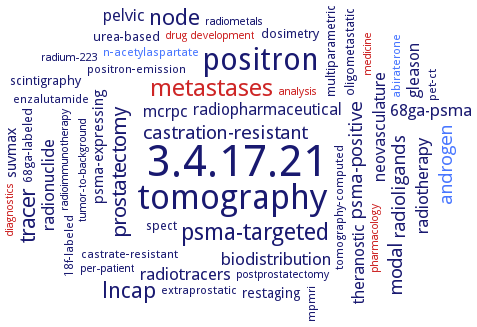3.4.17.21: Glutamate carboxypeptidase II
This is an abbreviated version!
For detailed information about Glutamate carboxypeptidase II, go to the full flat file.

Word Map on EC 3.4.17.21 
-
3.4.17.21
-
tomography
-
positron
-
metastases
-
psma-targeted
-
node
-
lncap
-
tracer
-
prostatectomy
-
castration-resistant
-
modal
-
radioligands
-
androgen
-
psma-positive
-
radiotherapy
-
radionuclide
-
68ga-psma
-
biodistribution
-
radiotracers
-
neovasculature
-
radiopharmaceutical
-
mcrpc
-
theranostic
-
pelvic
-
gleason
-
psma-expressing
-
suvmax
-
restaging
-
oligometastatic
-
68ga-labeled
-
multiparametric
-
urea-based
-
spect
-
dosimetry
-
scintigraphy
-
abiraterone
-
castrate-resistant
-
n-acetylaspartate
-
extraprostatic
-
mpmri
-
pet-ct
-
enzalutamide
-
18f-labeled
-
positron-emission
-
tomography-computed
-
radium-223
-
pharmacology
-
radioimmunotherapy
-
medicine
-
tumor-to-background
-
analysis
-
radiometals
-
postprostatectomy
-
per-patient
-
diagnostics
-
drug development
- 3.4.17.21
-
tomography
-
positron
- metastases
-
psma-targeted
- node
-
lncap
-
tracer
-
prostatectomy
-
castration-resistant
-
modal
-
radioligands
- androgen
-
psma-positive
-
radiotherapy
-
radionuclide
-
68ga-psma
-
biodistribution
-
radiotracers
-
neovasculature
-
radiopharmaceutical
-
mcrpc
-
theranostic
-
pelvic
-
gleason
-
psma-expressing
-
suvmax
-
restaging
-
oligometastatic
-
68ga-labeled
-
multiparametric
-
urea-based
-
spect
-
dosimetry
-
scintigraphy
- abiraterone
-
castrate-resistant
- n-acetylaspartate
-
extraprostatic
-
mpmri
-
pet-ct
-
enzalutamide
-
18f-labeled
-
positron-emission
-
tomography-computed
-
radium-223
- pharmacology
-
radioimmunotherapy
- medicine
-
tumor-to-background
- analysis
-
radiometals
-
postprostatectomy
-
per-patient
- diagnostics
- drug development
Reaction
release of an unsubstituted, C-terminal glutamyl residue, typically from Ac-Asp-Glu or folylpoly-gamma-glutamates =
Synonyms
100 kDa ileum brush border membrane protein, Acetylaspartylglutamate dipeptidase, altered meristem program1, AMP1, Dipeptidase, acetylaspartylglutamate, EC 3.4.19.8, FGCP, folate hydrolase, folate hydrolase 1, FOLH1, Folylpoly-gamma-glutamate carboxypeptidase, folylpoly-gamma-glutamate carboxypeptidase II, GCP II, GCPII, GCPIII, glutamate carboxypeptidase, glutamate carboxypeptidase II, glutamate carboxypeptidase III, GPCPII, I100, Ileal dipeptidylpeptidase, Membrane glutamate carboxypeptidase, mGCP, More, N-acetyl-alpha-linked acidic dipeptidase, N-acetyl-alpha-linked acidic dipeptidase I, N-acetylaspartylglutamate peptidase, N-acetylated alpha-linked acid dipeptidase, N-Acetylated alpha-linked acidic dipeptidase, N-Acetylated-alpha-linked acidic dipeptidase, N-acetylated-alpha-linked acidic dipeptidase 2, N-acetylated-alpha-linked acidic dipeptidase II, N-Acetylated-alpha-linked-acidic dipeptidase, N-acetylated-alpha-linked-acidic-dipeptidase, N-Acetylated-alpha-linked-amino dipeptidase, NAADLADase, NAADLADse, NAAG degradation enzyme, NAAG peptidase, NAAG peptidase II, NAAG-hydrolyzing activity, NAALA dipeptidase, NAALADase, Naaladase I, NAALADase II, NLD I, PMSA, prostate specific membrane antigen, Prostate-specific membrane antigen, Prostate-specific membrane antigen homolog, prostate-specificmembrane antigen, Prostrate-specific membrane antigen, PSM, PSM antigen, PSMA, Pteroylpoly-gamma-glutamate carboxypeptidase, Rat NAAG peptidase


 results (
results ( results (
results ( top
top





